[vc_row][vc_column][vc_column_text]
ApparelMagic was recently featured in California Apparel News for its powerful PLM features. ApparelMagic CEO John Murphy spoke with the media outlet about the importance of strong PLM in today’s fashion industry.
[/vc_column_text][vc_column_text]

Companies look to ApparelMagic’s PLM features when they need to track every important requirement during the product’s development and selling lifespan. From the very beginning stages, when designs are being reviewed, fabrications tested, specs revised, and when important decisions are made regarding sourcing and raw material choices, high-visibility PLM is not a luxury, it’s a mission-critical necessity.
Smaller companies who outsource production still need to record whether and when a garment has met compliance requirements (such as CPSIA, Prop 65, etc.). That’s why Mulberribush owner David Feinberg credits ApparelMagic for “the ability to trim costs, by better understanding the entire product and sales environment—labor, materials, production cycles, customer buying patterns.”
And larger companies, who typically control broader aspects of the development and supply chain, rely on ApparelMagic to track every important sign-off date and document reference in the testing and compliance process. According to Seven Licensing’s President and Chief Financial Officer Peter Akaragian, “Whether it’s a redesign to enhance the product’s appeal or a change in available fabric and sourcing, we use ApparelMagic’s PLM to determine our options and respond effectively.”
ApparelMagic’s unique “event history” tracking and document linking means that whether data is stored directly in our system or referenced by document number, the managers have instant access to requests, responses and the current status of certifications. They can even call up instant images of the certificates themselves.
But PLM requirements go far beyond formal certifications. ApparelMagic also presents a unified view of product history, including lab dips, customer approvals, details on the origin and consumption of raw materials, management of design sign-offs, technical drawings and photo images of garments, trims and accessories.
Once the product has survived the development process, ApparelMagic provides in-depth analysis of its sales performance and relative contribution to the bottom line. Ranking and analytical reports provide decision support to justify expanding the product, revising or retiring it, based on clear visibility of its performance over time. Badgley Mischka President Christine Bell Currence states, “ApparelMagic’s PLM system has given us a significant boost in efficiency in many different departments. We use the system throughout the company to share data with designers, customer-service agents, production and inventory-control departments, even our warehouse fulfillment partners.
Today’s most advanced and competitive players require a PLM that is light years ahead of what was expected even five years ago. Web access to far-flung offices and personnel is demanded. Drag and drop image management is essential. Onboard email integration for transmitting transactions, tech packs and approval forms is expected. By meeting these demands, ApparelMagic strives to give the modern apparel company, whether startup or industry veteran, the best PLM tools for success.[/vc_column_text][/vc_column][/vc_row]







